Lattan Mosque
| Lottan Masjid | |
|---|---|
লোটন মসজিদ | |
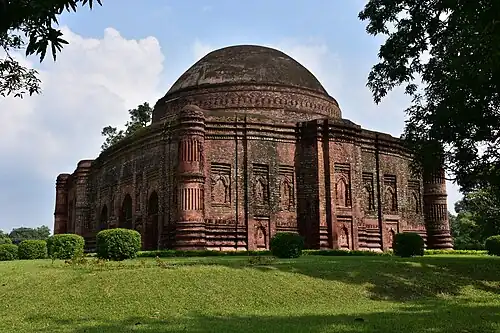 | |
| Religion | |
| Affiliation | Islam (former) |
| Ecclesiastical or organizational status | Mosque (former) |
| Status | Inactive (as a mosque) |
| Location | |
| Location | Gour Road, Gour, Malda, West Bengal |
| Country | India |
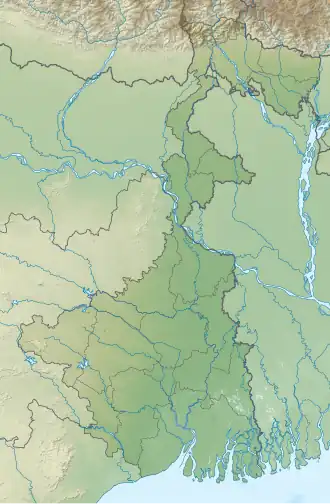 Location of the former mosque in West Bengal | |
| Administration | Archaeological Survey of India |
| Geographic coordinates | 24°52′58″N 88°07′41″E / 24.8829°N 88.1280°E |
| Architecture | |
| Type | Mosque architecture |
| Style | Bengal Sultanate |
| Date established | c. 1493-1519 |
| Specifications | |
| Length | 21.95 m (72.0 ft) |
| Width | 15.54 m (51.0 ft) |
| Dome(s) | 1 |
| Materials | Brick |
| Official name | Lottan Masjid |
| Reference no. | N-WB-92 |
The Lattan Mosque (Bengali: লোটন মসজিদ) or Painted Mosque, officially known as Lottan Masjid[1] is a historical mosque located between the Tantipara Mosque and the Bridge of Five Arches in Gaur, Malda District, West Bengal.[2] Built during the period of Hussain Shahi sultans between (c. 1493-1519), the mosque stands out as one of the best preserved monuments in ancient city of Gaur.[3]
History
The mosque is stylistically dated to the late 15th or early 16th century and is thought to have been constructed during the Husain Shahi period.[2][3] An inscription found in the vicinity indicates it may have been built by Sultan Shamsuddin Yusuf Shah (r. 1474–1481) in 1475. Alexander Cunningham describes the inscription of the Chamkatti Mosque instead.[4] Although the exact exact date of the mosque's construction is not known, historians assume the mosque was built somewhere between 1493 and 1519.[5]
According to local tradition, Yusuf Shah married a Hindu dancer called Mira (or Mirabai) who had embraced Islam and taken the name Lotan Bibi.[6] In her name, Yusuf Shah established the Lotan Taluq (administrative subdivision) which contains the Lattan Mosque and Lotan Dighi, and that taluq existed even until the British period.[7]
Architecture
The structure is entirely constructed from brick. It comprises a square prayer chamber measuring 10.36 m (34.0 ft) on each side, adjoined by a verandah measuring 10.36 by 3.35 m (34.0 by 11.0 ft). Together, they form a rectangular platform extending 21.95 m (72.0 ft) from east to west and 15.54 m (51.0 ft) from north to south. Access to the prayer chamber is provided through three arched openings on each side, except the qibla side. The qibla wall features three semi-circular mihrab niches, recessed internally and aligned to correspond with the three eastern entrances.[2] The interior is adorned with numerous multicolored glazed tiles. The intricately designed brick exterior was originally clad with glazed tiles, though much of this decoration has been lost.[3]
Gallery
-
.jpg) Full view of the monument
Full view of the monument -
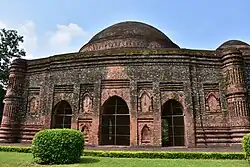 Front view
Front view -
 Side view
Side view -
 Back view
Back view -
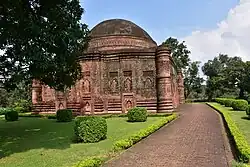 Entrance path to the mosque
Entrance path to the mosque -
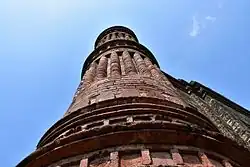 Corner pillars of Lattan Mosque
Corner pillars of Lattan Mosque -
 Intricate carvings on the wall
Intricate carvings on the wall -
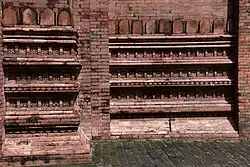 Decorated wall surface
Decorated wall surface -
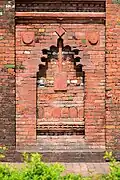 Wall architecture
Wall architecture -
 Floral designs on the corner pillar
Floral designs on the corner pillar -
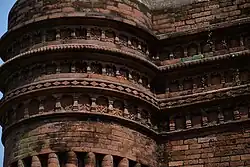 Works on pillar
Works on pillar
See also
References
- ^ "Alphabetical List of Monuments - West Bengal". Archeological Survey of India. Archived from the original on 23 June 2014. Retrieved 10 June 2025.
- ^ a b c Bari, MA (2012). "Lattan Mosque". In Sirajul Islam; Miah, Sajahan; Khanam, Mahfuza; Ahmed, Sabbir (eds.). Banglapedia: the National Encyclopedia of Bangladesh (Online ed.). Dhaka, Bangladesh: Banglapedia Trust, Asiatic Society of Bangladesh. ISBN 984-32-0576-6. OCLC 52727562. OL 30677644M. Retrieved 20 August 2025.
- ^ a b c Michell 1984, p. 77.
- ^ Ahemd, Sultan (2012). "Chamkatti Mosque". In Sirajul Islam; Miah, Sajahan; Khanam, Mahfuza; Ahmed, Sabbir (eds.). Banglapedia: the National Encyclopedia of Bangladesh (Online ed.). Dhaka, Bangladesh: Banglapedia Trust, Asiatic Society of Bangladesh. ISBN 984-32-0576-6. OCLC 52727562. OL 30677644M. Retrieved 20 August 2025.
- ^ Michell 1984, p. 150.
- ^ Sarkar, Jagadish Narayan (1985). Hindu-Muslim Relations in Bengal: Medieval Period. Idarah-i Adabiyat-i-Delli. p. 53. ISBN 978-0-8364-1802-6.
- ^ Mondal, Sushila (1970). History of Bengal: The middle age, 1200–1526. Prakash Mandir.
Bibliography
- Michell, George (1984). The Islamic Heritage of Bengal. Unesco. ISBN 978-92-3-102174-9.